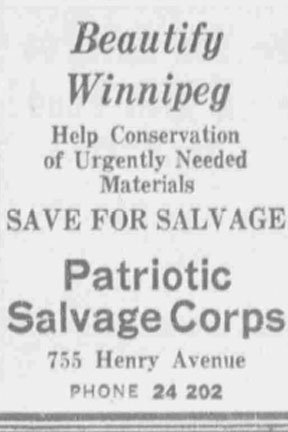
A call to beautify Winnipeg and save for salvage with the Patriotic Salvage Corps, 1945.
During the Second World War, Winnipeg residents had a different kind of recycling day. It was called Salvage Day.
Rather than tossing all used items away, people saved and donated many of them to help the war effort. For example, paper was needed for ammunition, mines and bombs. Rags were needed for uniforms, blankets, building materials, wipers. Broken glass could be melted and used again. Bones and fats were used for explosives, nitroglycerine, glue, fertilizer, poultry feeds. Magazines were provided as reading materials for military camps and hospitals.
Every block had a captain who would call their neighbours to advise them of what was needed and when to put it out on the boulevard for pickup. In 1943, this system raised $5,000 to $10,000 per month and was a role model for programs in other cities in North America.
We did it thanks to Winnipeg’s Patriotic Salvage Corps. They also collected donations of things people still liked, and fixed other things up to sell in stores. They held events. They wanted to make a difference for the war effort.
It all started in May 1940, when St. Boniface Hospital ran short of (glass) medicine bottles, and they put out the call to housewives to go through their medicine cabinets and see if they had any to spare. Donations stocked all six city hospitals. “A few days after householders were told salvage was needed for war plants, the response started an avalanche,” reported the Winnipeg Tribune on December 30, 1943.
A man was hired full-time to promote salvage collections and look at new markets. They collected 50,000 gramophone records in two weeks, enough to pay for a mobile kitchen unit in war-torn Britain. In three years, they sold six million pounds of broken glass. Kids collected rags and brought them to the theatres for a free show. They rented a store downtown to sell old books. They gathered old aluminum pans for airplane production by encouraging kids to hit an effigy of Hitler to win a free Coke.
During the Second World War, families including Dickies From Gunton: Canadian Brothers in Two World Wars supported the national salvage drive. It was launched in February 1941, two months after the Battle of Hong Kong, and before many families of Winnipeg Grenadiers knew the fate of their loved ones who were defeated there, including Earl.
By the end of December 1943, Ottawa reported that Winnipeg’s average salvage contributions per capita since 1940 were 96 pounds, nearly three times the average for the rest of Canada. What an amazing accomplishment during difficult times, well before anyone had ever heard of a blue box.
And then, Winnipeg’s Patriotic Salvage Corps officially ended their operations on June 9, 1967, due to disappearing markets and insufficient returns. Bottles, magazines and newspapers are now headed for the garbage cans, reported the Winnipeg Tribune that day. “It will be up to the city to pick up the extra loads with their regular garbage crews.”

Yes. Unfortunate.
That was really an interesting story. It is sure too bad that program came to an end.